Imagine transforming your outdated bathroom into a stunning oasis, complete with modern fixtures and finishes. With the right approach, renovating a bathroom – what to do first? This step-by-step guide will walk you through the process of renovating your bathroom, from identifying your goals and assessing the current space to choosing materials and obtaining necessary permits. Let’s dive in!
Key Takeaways
- Identify your goals and priorities for a successful bathroom renovation.
- Assess the current space to identify structural issues, fixture conditions, and layout changes.
- Choose materials & fixtures carefully while staying within budget & hiring professionals when needed!
Identify Your Goals and Priorities
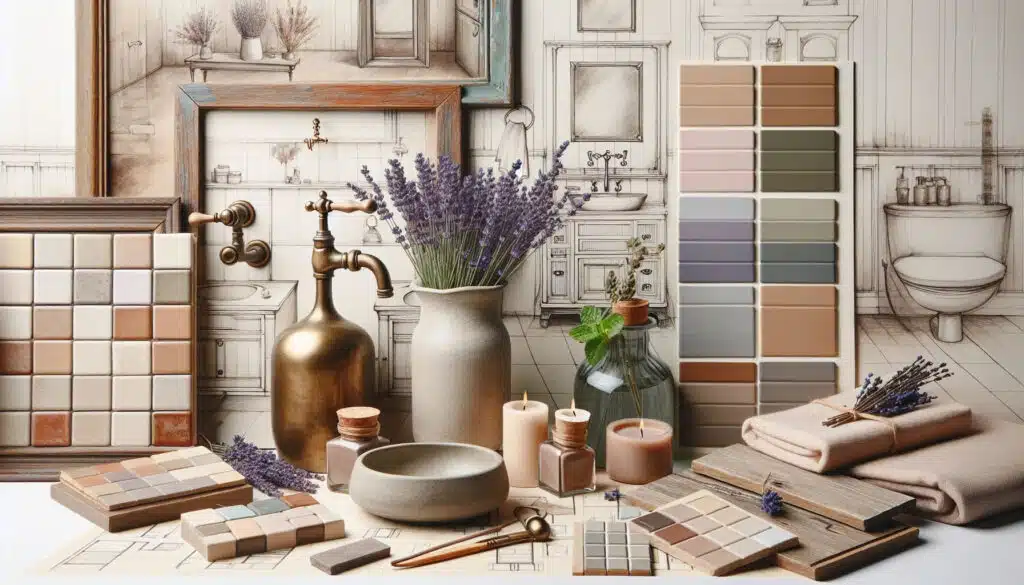
As you prepare for your bathroom renovation, establishing your goals and priorities becomes an important first step. What do you want to achieve with this project? Are you looking for a cosmetic upgrade, a complete overhaul, or a bathroom makeover? Creating a bathroom remodel checklist from clear objectives can lead to a successful bathroom remodel while avoiding costly mistakes.
We can categorize these goals into three main areas: aesthetic goals, functional goals, and budget constraints.
Aesthetic Goals
An aesthetically pleasing bathroom, especially a master bathroom, can significantly impact your daily routine and the overall value of your home. When considering the desired look and feel of your new bathroom, think about the color schemes, materials, and design elements you want to incorporate to create your dream bathroom. Visiting local home improvement stores or browsing online galleries can provide inspiration and help narrow down your choices.
For example, you may opt for a modern design with sleek lines, minimalist fixtures, and a calming color palette. Or perhaps a traditional style with warm wood tones and classic details is more your taste. Ultimately, the choice is yours, and the possibilities are endless.
Functional Goals
While aesthetics are important, functionality should never be overlooked. A well-designed bathroom must meet your practical needs, making life easier and more enjoyable. Consider aspects such as storage, layout, and fixture upgrades when setting your functional goals. For example, you may want to increase storage with a new vanity, improve lighting for better visibility, or upgrade your shower stall for a more luxurious experience. Incorporating bathroom design ideas that focus on both aesthetics and functionality will ensure a successful renovation.
Clear functional objectives will result in a bathroom that’s not just beautiful, but also efficient and user-friendly.
Budget Constraints
Budget constraints play a significant role in determining the scope and outcome of your bathroom renovation. Establishing a realistic budget will help you make informed decisions about materials, fixtures, and whether to hire professionals or tackle the project on your own.
Keep in mind that the average bathroom remodel cost is around $10,753. However, this number can vary based on factors such as project scope, material quality, and labor costs. It’s also wise to allocate 5-10% of your total budget for contingencies, as unexpected expenses can arise during bathroom remodels.
Assess the Current Space
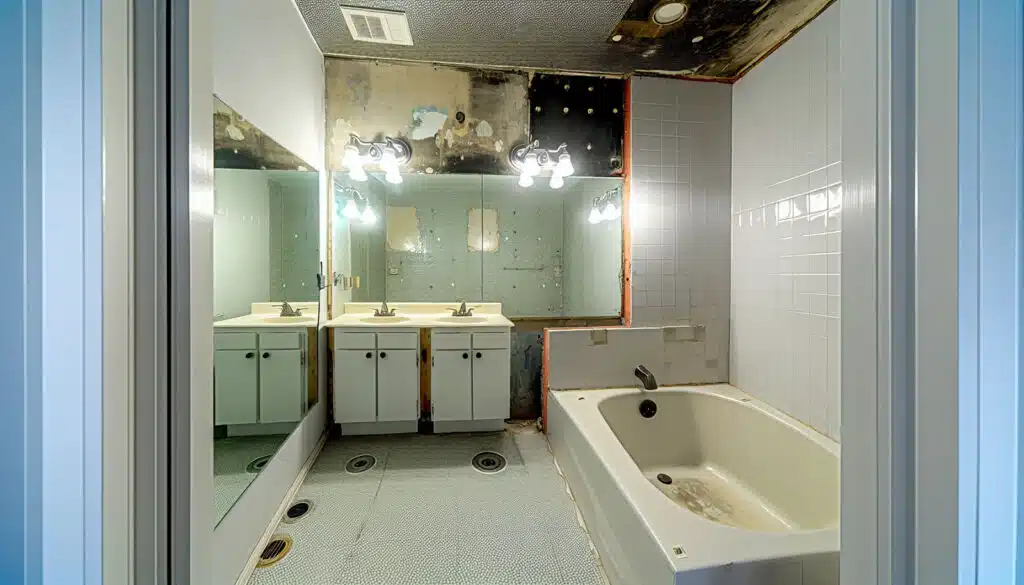
Having set your goals and budget, you can now assess your current bathroom space. This crucial step involves evaluating structural issues, fixture conditions, and potential layout changes. Understanding the existing state of your bathroom will help guide your renovation decisions and ensure a smoother process.
We will delve deeper into these assessment categories.
Structural Issues
Addressing structural issues is vital for a safe and long-lasting renovation. Examine your bathroom’s electrical wiring, plumbing, and insulation to identify any potential problems. If issues are discovered, they may require additional work and budget allocation.
Assessing structural issues can help avoid potential hazards and contribute to a successful renovation.
Fixture Condition
Evaluating the condition of your existing bathroom fixtures is essential to determine which items need repair, replacement, or upgrading. Examine the toilet, sink, bathtub, and other fixtures for signs of wear or damage. This will help you decide whether to replace certain fixtures or simply upgrade them to better suit your new bathroom design.
Layout Changes
Considering layout changes can significantly improve the functionality and flow of your bathroom space. If your current layout isn’t meeting your needs or you simply want a fresh look, explore options such as relocating fixtures, adding or removing walls, and changing the overall design. Keep in mind that some layout changes may involve adjustments to plumbing and electrical wiring, so be prepared to factor in these additional costs and considerations.
Develop a Project Timeline
Once your goals and priorities have been set and your current space assessed, you can move on to developing a project timeline. Creating a well-defined timeline is critical for keeping your renovation on track and ensuring a successful outcome. Consider factors such as contractor scheduling, material ordering, and contingency planning when developing your timeline.
A clear schedule prepares you better to manage each phase of the renovation process.
Contractor Scheduling
If you’re working with contractors, coordinating their schedules is essential for a smooth and efficient renovation process. Make sure to book contractors well in advance (at least three to four months) to secure their services and avoid potential delays.
Regular communication with your contractors will also help you stay informed about their progress and address any issues that may arise during the renovation.
Material Ordering
Ordering materials in advance is crucial to avoid delays and ensure the availability of your desired products. Once you’ve chosen your materials and fixtures, place your orders as early as possible. This will give you ample time for any potential backorders or shipment delays.
Be sure to coordinate the delivery dates of your materials with your renovation schedule, so everything arrives when needed.
Contingency Planning
No matter how well you plan, unexpected issues or delays can still occur during a renovation. To prepare for any surprises, allocate extra time and budget for contingencies. Having a contingency plan in place will help you navigate these unforeseen obstacles and keep your renovation on track.
Choose Your Materials and Fixtures
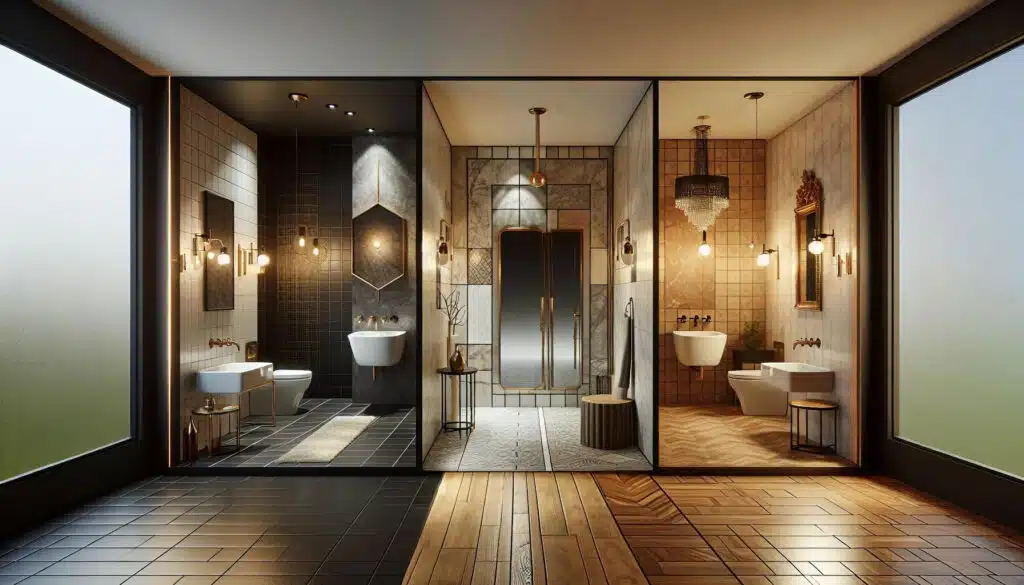
Selecting the right materials and fixtures is key to achieving the bathroom of your dreams. From flooring to lighting, each element should complement your design vision and meet your functional needs. Consider factors such as durability, maintenance, and budget when making your selections.
Let’s explore some popular options for flooring, fixtures, and wall and lighting options at your local home improvement store.
Flooring Options
Your bathroom flooring should be both visually appealing and practical. Some excellent choices for bathroom flooring include bathroom tiles, which are a popular option due to their durability and water resistance. Other options include:
- Vinyl: Vinyl offers a budget-friendly alternative to tile, with a wide range of styles and designs available.
- Laminate: Laminate flooring is another affordable option, offering the look of hardwood or tile at a lower cost.
Consider your budget, style preferences, and maintenance requirements when choosing the best flooring option for your bathroom.
When selecting your flooring, consider factors such as slip resistance, ease of maintenance, and overall design compatibility.
Fixture Selection
Choosing the right fixtures can elevate your bathroom’s functionality and aesthetic appeal. Consider options for:
- Sink fixtures
- Faucets
- Toilets
- Showers or tubs
that meet your needs and preferences. Keep in mind that the style, material, and finish of your fixtures should complement the overall design of your bathroom.
Don’t be afraid to splurge on high-quality fixtures, as they can greatly enhance your bathroom’s resale value when you install vanity.
Wall and Lighting Options
Wall and lighting options play a crucial role in creating a cohesive and inviting bathroom ambiance. For the walls, you can choose to paint walls, tile, or use other wall coverings such as shower walls, depending on your design preferences. As for lighting, consider a mix of ambient, task, and accent lighting to achieve the desired atmosphere.
Don’t forget to choose fixtures and finishes that coordinate well with the rest of your bathroom design.
Hire Professionals or DIY?
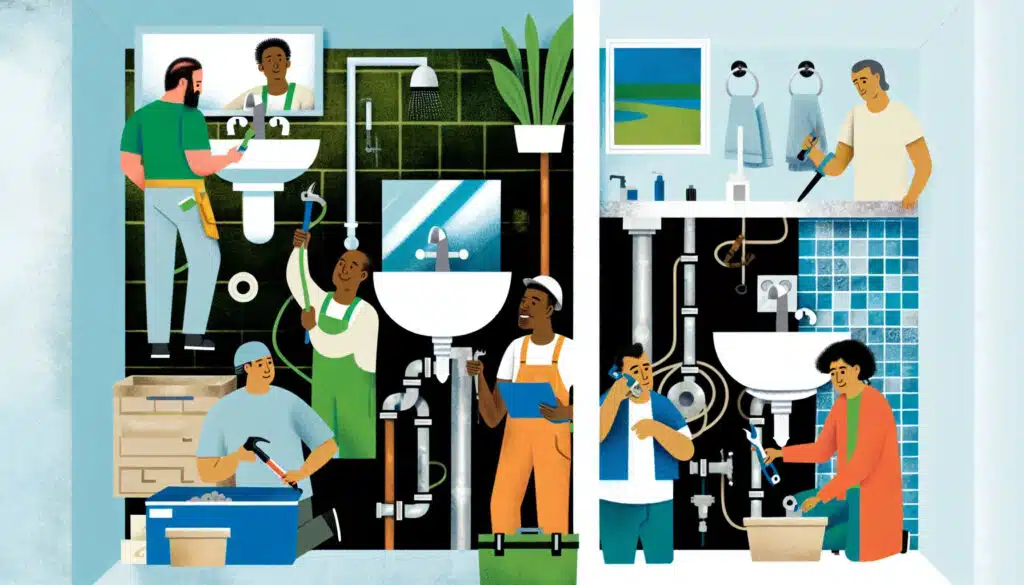
One of the biggest decisions you’ll face during your bathroom renovation is whether to hire professionals or take on a DIY approach. Both options have their pros and cons, so it’s important to carefully consider factors such as your experience, time constraints, and potential cost savings.
We will examine some of the key aspects of plumbing, electrical work, and fixture installation to help guide your decision.
Plumbing and Electrical Work
Plumbing and electrical work are typically best left to professionals. These tasks require specialized knowledge and expertise to ensure safety and compliance with local building codes. While DIY plumbing and electrical work may save you money on labor costs, improper installations can lead to costly repairs and safety hazards down the line.
Hiring a licensed professional can provide peace of mind and a higher quality outcome.
Installation of Fixtures and Finishes
When it comes to installing fixtures and finishes, the decision to DIY or hire professionals depends on your skill level, available time, and desired results. DIY installation can save you money on labor costs, but may require more time and effort. Additionally, if you lack experience, the end result may not meet your expectations.
On the other hand, hiring professionals can ensure a more polished final product, but may come at a higher cost.
DIY Savings vs. Professional Expertise
Weighing the potential cost savings of DIY projects against the expertise and efficiency provided by professional contractors is essential. While DIY can save you money on labor costs, it may take more time and effort to achieve the desired results. Professional contractors bring experience and knowledge to the table, ensuring a higher quality outcome in a shorter time frame.
Ultimately, the choice between DIY and hiring professionals will depend on your personal preferences, budget, and confidence in your abilities.
Obtain Necessary Permits
Securing the necessary permits to comply with local building codes and regulations is an essential step before starting your bathroom renovation. Acquiring permits may seem like a bureaucratic hassle, but it’s a crucial step to guarantee a safe and successful renovation. Depending on the scope of your project, you may need permits for:
- Structural changes
- Electrical work
- Plumbing
- Fixture additions
Consult your local building department to determine the specific permits required for your renovation.
Begin the Renovation Process
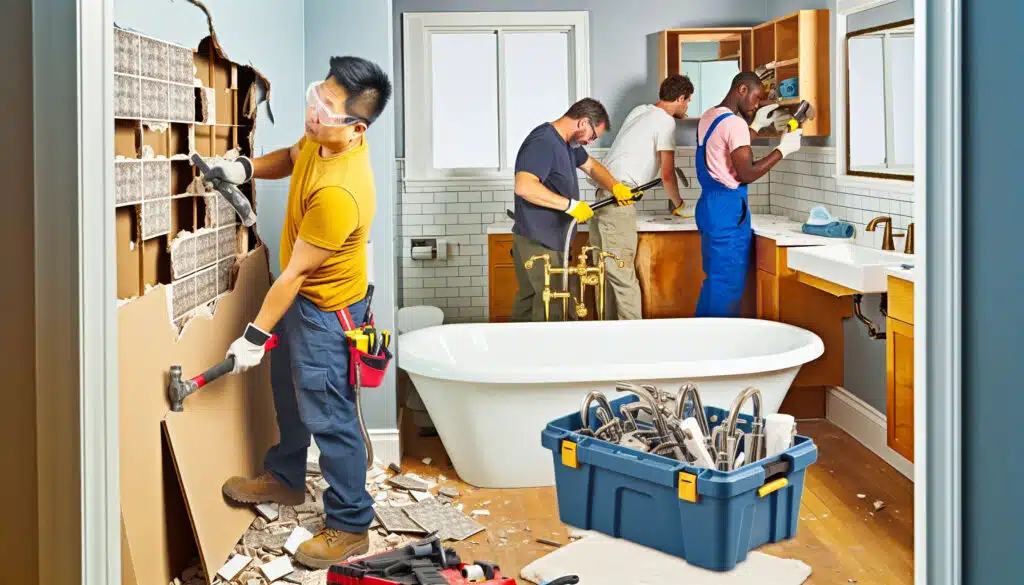
Having set goals, obtained permits, and chosen materials and fixtures, you can now commence the exciting renovation process! This phase involves demolition, plumbing and electrical updates, and installation of new fixtures and finishes. As you work through each step, keep your project timeline and budget in mind, making adjustments as needed.
We will delve into each stage of the renovation process in more detail.
Demolition
The demolition phase is your opportunity to remove old fixtures and finishes, preparing the space for renovation. Here are the steps to follow:
- Disconnect the electricity and water supply to the bathroom, ensuring a safe working environment.
- Carefully remove fixtures such as the toilet, sink, shower, and bathtub.
- Remove any wall tiles or drywall that need to be replaced.
- Be cautious not to damage any underlying pipes or wiring during the demolition process.
Plumbing and Electrical Updates
As you update your bathroom’s plumbing and electrical systems, it’s important to consider any new fixtures or layout changes that require adjustments. This may involve installing new pipes, rerouting wiring, or upgrading electrical circuits to accommodate additional lighting or outlets. If you’re not confident in your ability to tackle these tasks, hiring a licensed professional is highly recommended.
Installation of New Fixtures and Finishes
The final stage of your bathroom renovation involves installing new fixtures and finishes according to your chosen design, which is an essential part of bathroom renovations. This includes items such as:
- Sinks
- Faucets
- Toilets
- Showers or tubs
- Flooring
- Wall coverings
- Lighting
As you install each element, ensure proper functionality and a polished final result. With careful planning and attention to detail, your bathroom renovation will transform your space into a beautiful and functional oasis, making your bathroom project a success.
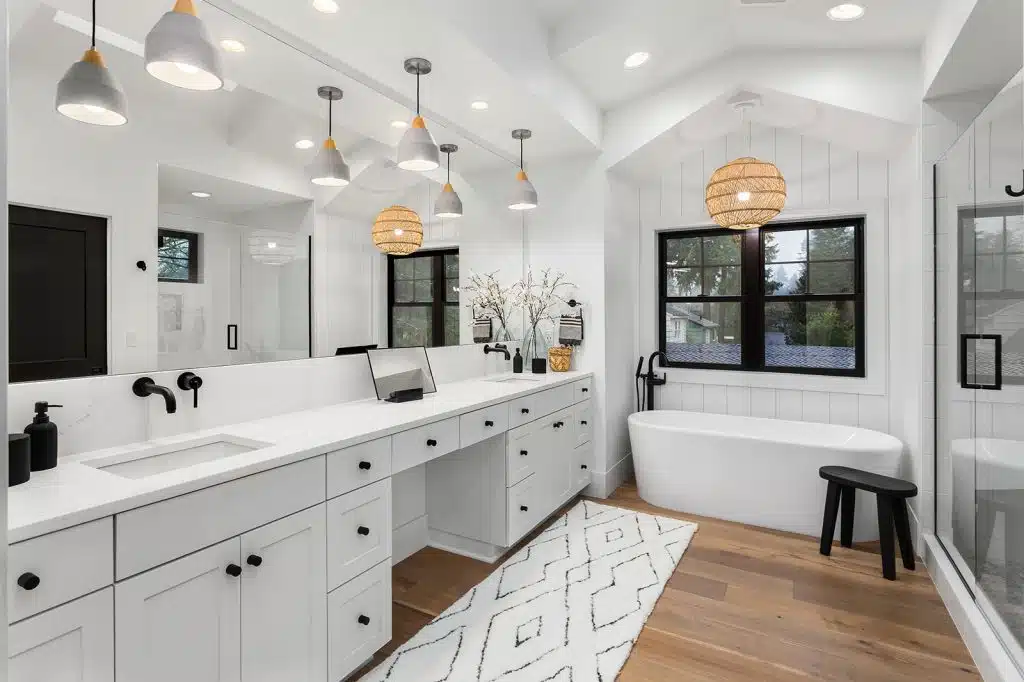
Summary
In conclusion, a successful bathroom renovation requires careful planning, goal setting, and attention to detail. By following this step-by-step guide, you can transform your outdated bathroom into a stunning and functional space that enhances your daily life and adds value to your home. Whether you choose to hire professionals or take on a DIY approach, a well-executed bathroom renovation will reward you with a beautiful and efficient space to enjoy for years to come.
Frequently Asked Questions
In what order do you renovate a bathroom?
When remodeling a bathroom do you do the floor first?
What do I need to know before remodeling a bathroom?
What factors should I consider when setting a budget for my bathroom renovation?
What are some common challenges to be aware of when undertaking a DIY bathroom renovation?

You must be logged in to post a comment.